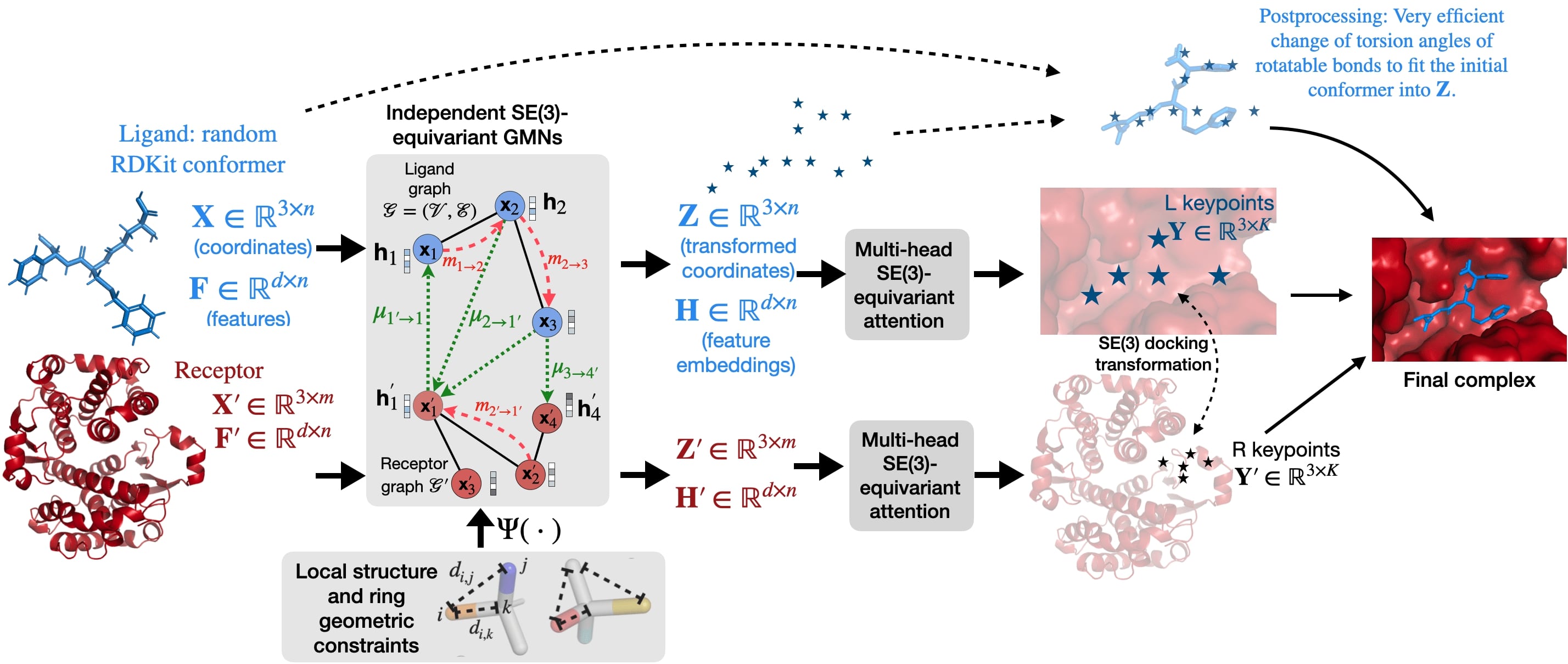EquiBind, is a SE(3)-equivariant geometric deep learning model performing direct-shot prediction of both i) the receptor binding location (blind docking) and ii) the ligand’s bound pose and orientation. EquiBind achieves significant speed-ups and better quality compared to traditional and recent baselines. If you have questions, don't hesitate to open an issue or ask me via hannes.staerk@tum.de or social media or Octavian Ganea via oct@mit.edu. We are happy to hear from you!
Our preprocessed data (see dataset section in the paper Appendix) is available from zenodo.
The files in data contain the names for the time-based data split.
If you want to train one of our models with the data then:
- download it from zenodo
- unzip the directory and place it into
datasuch that you have the pathdata/PDBBind
Ligand files of the formats .mol2 or .sdf or .pdbqt or .pdb whose names contain the string ligand.
Receptor files of the format .pdb whose names contain the string protein.
For each complex you want to predict you need a directory containing the ligand and receptor file. Like this:
my_data_folder
└───name1
│ name1_protein.pdb
│ name1_ligand.sdf
└───name2
│ name2_protein.pdb
│ name2_ligand.mol2
...
We will set up the environment using Anaconda. Clone the current repo
git clone https://github.com/HannesStark/EquiBind
Create a new environment with all required packages using environment.yml. If you have a CUDA GPU run:
conda env create -f environment.yml
If you instead only have a CPU run:
conda env create -f environment_cpuonly.yml
Activate the environment
conda activate equibind
Here are the requirements themselves for the case with a CUDA GPU if you want to install them manually instead of using the environment.yml:
python=3.7
pytorch 1.10
torchvision
cudatoolkit=10.2
torchaudio
dgl-cuda10.2
rdkit
openbabel
biopython
rdkit
biopandas
pot
dgllife
joblib
pyaml
icecream
matplotlib
tensorboard
In the config file configs_clean/inference.yml set the path to your input data folder inference_path: path_to/my_data_folder.
Then run:
python inference.py --config=configs_clean/inference.yml
Done! 🎉
Your results are saved as .sdf files in the directory specified
in the config file under output_directory: 'data/results/output' and as tensors at runs/flexible_self_docking/predictions_RDKitFalse.pt!
Download the data and place it as described in the "Dataset" section above.
To predict binding structures using the provided model weights run:
python inference.py --config=configs_clean/inference_file_for_reproduce.yml
This will give you the results of EquiBind-U and then those of EquiBind after running the fast ligand point cloud fitting corrections.
The numbers are a bit better than what is reported in the paper. We will put the improved numbers into the next update of the paper.
To train the model yourself, run:
python train.py --config=configs_clean/RDKitCoords_flexible_self_docking.yml
The model weights are saved in the runs directory.
You can also start a tensorboard server tensorboard --logdir=runs and watch the model train.
To evaluate the model on the test set, change the run_dirs: entry of the config file inference_file_for_reproduce.yml to point to the directory produced in runs.
Then you can runpython inference.py --config=configs_clean/inference_file_for_reproduce.yml as above!
📃 Paper on arXiv
@misc{stark2022equibind,
title={EquiBind: Geometric Deep Learning for Drug Binding Structure Prediction},
author={Hannes Stärk and Octavian-Eugen Ganea and Lagnajit Pattanaik and Regina Barzilay and Tommi Jaakkola},
year={2022}
}

